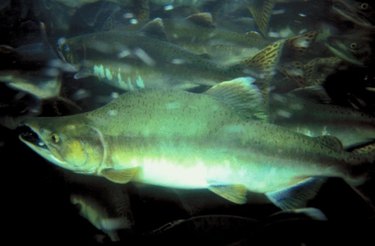
Sockeye, king, chum, Atlantic, pink, silver and silverbrite all refer to different types of salmon. To the novice fisherman or chef interested in these fish, the names can be confusing or even misleading. If you are serving or preparing a salmon dinner, knowing which fish you are purchasing can be crucial to the success of the meal. Silverbrite and sockeye salmon are both types of wild Pacific salmon that look similar, but their taste and quality are vastly different.
Silverbrite: Appearance
Video of the Day
Silvebrite salmon are usually known as chum salmon or commonly referred to as dog salmon. The name silverbrite appears to be used only for marketing purposes. Chum salmon grow to be large, averaging about 8 to 12 pounds and 25 inches long. In the ocean, chum salmon resemble sockeye salmon as they are silver and greenish blue. But when they enter fresh water at spawning time, the salmon become speckled with purple blotches and red and black stripes. Male chum salmon have very large teeth that resemble canine teeth, resulting in their nickname "dog salmon."
Video of the Day
Sockeye: Appearance
Sockeye salmon are smaller than silverbrite, usually weighing 6 to 8 pounds as adults. In the ocean, sockeye salmon are greenish blue, with silver sides and bellies. Their appearance changes drastically when they enter fresh water to spawn, taking on a brilliant red and developing fatty humps on the back. The crimson color of the spawning sockeye salmon is the reason these fish are commonly referred to as "red salmon."
Silverbrite: Food Value
Of all the types of Pacific wild salmon, the silverbrite, or chum salmon, is considered to have the least desirable food value. They are not as fatty or tasty as other types of salmon and have obtrusive bones. Generally speaking, chum or silverbrite salmon flesh is not consumed and these fish are harvested only for their roe. However, people in various Alaskan villages consider chum salmon to be an important subsistence food source, and smoke these fish for the winter. Villagers also commonly feed these fish to their dog teams, offering another explanation for why chum salmon are referred to as "dog salmon."
Sockeye: Food Value
Sockeye salmon are the darlings of the food industry, providing a bright red and succulent salmon fillet. Many restaurants serving wild salmon consider sockeye to be the tastiest fish on the market. Sockeye salmon are well known for their high quality oily flesh, and thus command a higher market price than other types. Many fish markets and fishermen refer to this fish as "red salmon" because of its bright red flesh at spawning time.